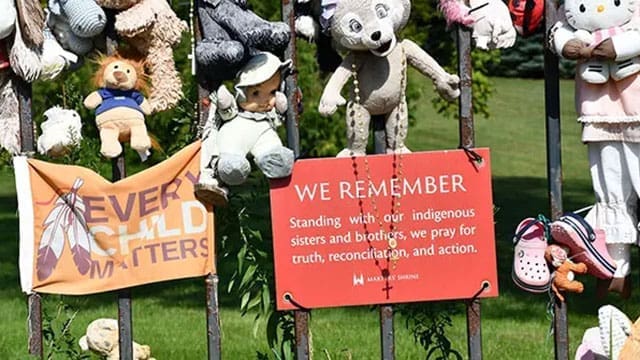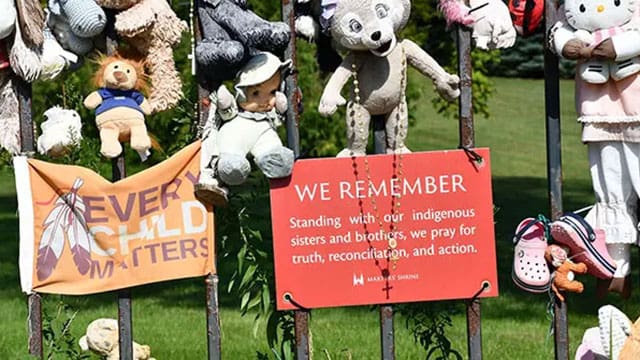Canadian institutions slammed for buying into false Kamloops mass graves claim
 The third anniversary of the Kamloops claim – that 215 Indigenous students died under suspicious circumstances and were buried in secret at a local residential school – is approaching. Despite the passage of time, no excavations have been conducted, and it seems unlikely any will occur, suggesting that the initial claims were baseless.
The third anniversary of the Kamloops claim – that 215 Indigenous students died under suspicious circumstances and were buried in secret at a local residential school – is approaching. Despite the passage of time, no excavations have been conducted, and it seems unlikely any will occur, suggesting that the initial claims were baseless.
The claim of mass graves was first made by a junior academic who reported detecting soil disturbances using ground-penetrating radar. These disturbances were likely old septic system tiles, not bodies. So it is unsurprising that the Kamloops band reneged on its promise to release her report.
Other Indigenous communities that excavated, driven by stories of sinister deaths and secret priest burials, discovered that the stories were untrue. Their excavations turned up nothing but stones.
The real question is why the easily disprovable Kamloops and copycat claims that followed were taken seriously in the first place. Why, for example, was CBC so quick to definitively announce “mass graves”, “human remains”, and “graves”, when nothing of the sort was found? And why was the Trudeau government so quick to give credence to the very thin claim by lowering flags, kneeling with a teddy bear, and promising hundreds of millions of dollars to any indigenous communities tempted to make a similar claim?
Such reactions expose a broader issue of gullibility within Canadian institutions toward improbable and unsupported claims. This pattern was arguably set by the Truth and Reconciliation Commission (TRC), influenced by figures like Kevin Annett, a known conspiracy theorist. Annett, whose claims have been widely discredited, alleged that thousands of Indigenous children were murdered and concealed by residential schools. These claims were featured prominently in his film Unrepentant and gained traction on social media and among some political figures.
Despite the dubious nature of Annett’s narratives – ranging from children being killed by nuns to the outlandish claim that the late Queen Elizabeth kidnapped 10 Kamloops students who were never seen again – the TRC, swayed by his assertions, prioritized a search for these “missing children,” a quest not originally within their mandate. Despite the lack of supporting historical evidence or testimonial corroboration during the TRC hearings, the commissioners continued to follow this line of inquiry.
TRC commissioner Murray Sinclair and others hinted at dark tales of abuse and murder, which they often presented without solid evidence. This approach culminated in the 2021 Kamloops claim, which led to a wave of church burnings and the propagation of a false narrative fueled by unverified, sensational stories.
At one point, commissioner Marie Wilson theatrically “spoke” to these imagined missing children:
“We know that a quarter of you left this world without the dignity of having your name recorded. A third of you left without anyone noting whether you were a boy or a girl. And fully half of you passed on without the cause of death being recorded.”
Wilson also alleged that “thousands of indigenous children were ripped out of their mothers’ arms, never to be seen again.” Sinclair increased the “thousands” to “25,000.”
The commissioners, who were charged with finding the “truth,” were instead spreading misinformation.
There is not one scintilla of evidence to support these reckless claims of mass graves. Indigenous children died in equal numbers from disease whether they went to residential schools, day schools, or no school at all. The deaths of the residential school students who died were properly recorded, and most were buried on their home reserves by their parents. Many burial sites were forgotten because grave sites and cemeteries went untended, thus leading to “forgotten children.”
The aftermath has been deeply damaging. The Indigenous community, along with the broader Canadian public, has been led to believe a narrative now recognized as false. However, this narrative is currently being integrated into educational materials and accepted by major institutions without critical scrutiny.
Ultimately, the responsibility lies with the TRC commissioners, whose acceptance of unsubstantiated stories about mass graves from unreliable sources like Annett led to a national crisis. This situation underscores the challenges of distinguishing between heartfelt, necessary reconciliation efforts and the dangers of embracing unverified claims that can incite harm and division.
This tragic misstep demonstrates a critical need for rigorous verification of historical allegations to prevent the dissemination of misinformation and ensure that the pursuit of truth does not give way to the spread of potentially harmful myths.
Brian Giesbrecht, a retired judge, is a Senior Fellow at the Frontier Centre for Public Policy.
For interview requests, click here.
The opinions expressed by our columnists and contributors are theirs alone and do not inherently or expressly reflect the views of our publication.
© Troy Media
Troy Media is an editorial content provider to media outlets and its own hosted community news outlets across Canada.


